The Future of B2B eCommerce in Spain

Increasingly, B2B companies are choosing to implement eCommerce platforms with the purpose of streamlining their operations, expanding their reach and enriching the customer experience. For this reason, it is very important to engage in conversations that involve understanding and analyzing the trends that are transforming this constantly evolving sector.
Let's talk about the future of B2B eCommerce in Spain
On this occasion, Leandro Benítez, General Manager of Novicell, and Gonzalo de Caralt, Regional Account Manager for Iberia at BigCommerce, who has a large Expertise in the field of eCommerce. They will address the different challenges and trends that emerge in the e-commerce landscape in Spain.
Leandro: welcome everyone. We're here at another Novicell webinar. Many of you already know the house. We are a digital agency. We are in Spain, now from Barcelona, but the headquarters is in Denmark.
Today I have the pleasure of being here with Gonzalo from Bigcommerce. Welcome, Gonzalo. I am Leandro, Director of Novicell Spain. Gonzalo, what are we going to talk about today?
Gonzalo: Thank you. Well, we are going to talk about B2B e-commerce in Spain, it is a topic that has been very hot in recent years. We also have many new customers who are asking questions and who are entering this world. In addition, we realize that there is still a lot to do in Spain, which is very interesting.
Leandro: And there are also a lot of technological solutions.
Gonzalo: Right. The truth is that the technological landscape has changed a lot in the last two years for this sector. At BigCommerce, which is an e-commerce platform for both B2C and B2B, we are highly positioned and have developed very good functionality.
Leandro: in B2B, because you've been in the market for almost as long as the internet has been the internet. Not so much, but quite a lot. Okay, let's start! We would like to make a small introduction to B2B to keep everyone on the same level. What are we talking about when we talk about B2B and B2B eCommerce? Faced with a B2C eCommerce.
Gonzalo: Exactly. The first thing that comes to mind when they say B2B e-commerce is the typical manufacturer that has a distribution network and has to optimize sales to those distributors, so it installs a kind of customer portal. In recent years, these portals have been very rigid, very boring. But in such a dynamic world where things are changing so much, many more types of platforms for B2B businesses have emerged.
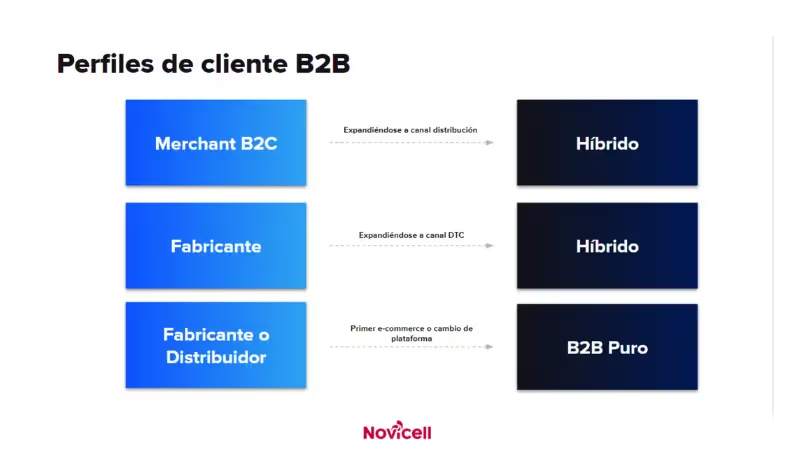
In the case of Bigcommerce, one type of frequent customer is Merchant retailers that sell in B2C, for example, in fashion, accessories, etc. Maybe it's an Retailer who has created a brand, has started opening stores, has their B2C portal and there comes a time when they start to want to sell to other multi-brand stores, in El Corte Inglés, to distributors, in other countries via a distributor. then need a tool that allows them to open a B2B business model, isn't it? In that case at BigCommerce we offer a hybrid portal. Let's say it works on the one hand for B2C and then you can do a Login for B2B management.
Another type of frequent customer is the manufacturer of a brand that had always sold through distributors to the market, but that began to attack the customer directly (D2C). We are seeing it in Spain, for example, in the pharma sector, in medicines over-the-counter, over-the-counter medications. There was a very rigid distribution structure in that market, now there are more manufacturers that have their own brand and want to go directly to the pharmacy. To do this, they open a B2B portal and bypass their distribution network. Well, it's changing very quickly.
Leandro: They skip the traditional process, let's say.
Gonzalo: Exactly. They go from being a purely B2B model to also having a B2C model, combining them thanks to a hybrid portal.
Then there's the more traditional model, the manufacturer that wants to manage and optimize its sales to its distribution network.
Leandro: In other words, the B2B eCommerce model is booming. How is a B2B eCommerce portal different from a B2C eCommerce?
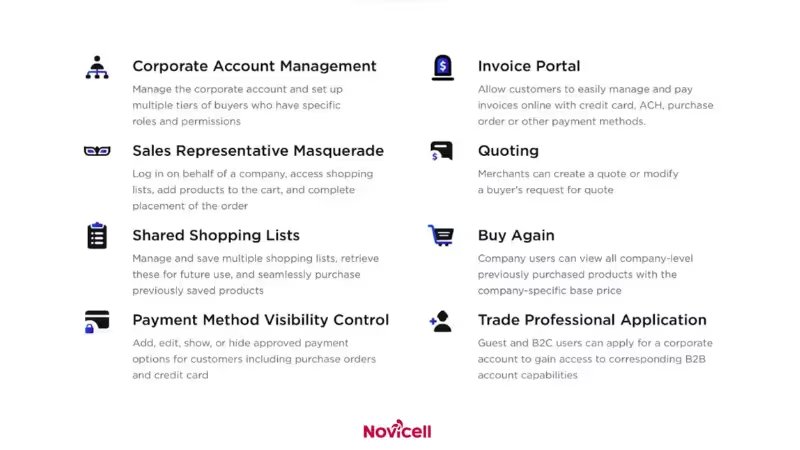
Gonzalo: Well, look, the most important thing is that when a customer enters a portal to buy for their business, they can have access as a company, not as a person. And then, beyond that, there are a whole series of dedicated functionalities. For example:
- Access to available invoices.
- Different roles for different buyers in large multinationals.
- Tools for making pre-purchase quotes.
- Possibility to negotiate prices and orders with a seller.
- Ability to make changes and collaborate on documents before closing an order
- Approval options for purchases.
- Facilities for placing repeat orders or bulk orders.
That's why I said before that the technological landscape has changed a lot, because only three or four years ago this didn't exist in the SaaS format, which we'll talk about later.
New software platforms, not only in the field of e-commerce but throughout the global digital environment, have mostly adopted the SaaS approach. What does it mean? Basically, these platforms offer predefined functionality, which is limited in terms of customization. This contrasts with the old norm, where B2B business models focused heavily on personalization, since each company had its own peculiarities. This is where experts such as Novicell come in, who make it possible to adapt technology to the business model.
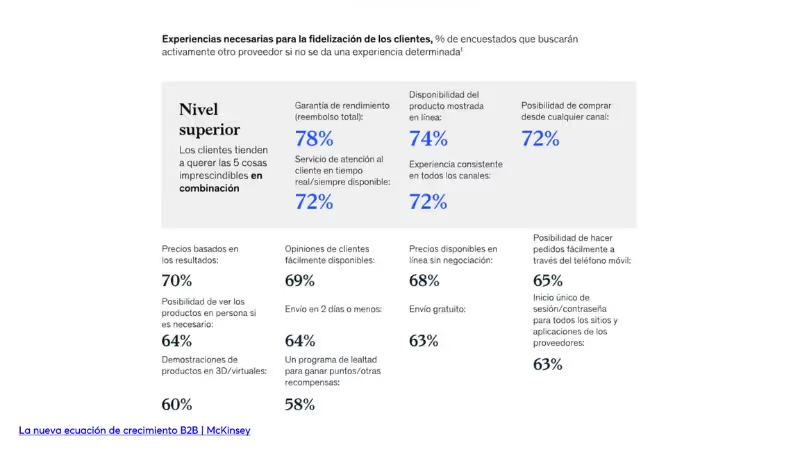
Leandro: this slide is a very cool survey, every time you start researching you get a lot of interesting information from how consumer habits are changing in B2B.
Gonzalo: Look, what these data show you is that B2B buyer behavior is increasingly similar to B2C. People have become used to entering a website and having a good user experience. In fact, manufacturers are going to seek to develop it for their own business. In addition, it tells you that if you are not offering this type of experience to your buyer, it is very easy for them to leave with a competitor.
A few years ago, changing suppliers was cumbersome”I don't like the seller very much, but look, they already serve me well, we've already gotten used to each other so that we can change, right?” But in a world where all competitors have a portal similar to that of your suppliers, because as soon as you find one that offers you a better experience and a very similar product, you are going to change. Unless you're buying a product that's very unique.
Evolution of B2B eCommerce in Spain
Leandro: Let's get a little more into the topic. What is B2B in Spain?
We are going to contextualize the state of this sector in Spain and see the trends.
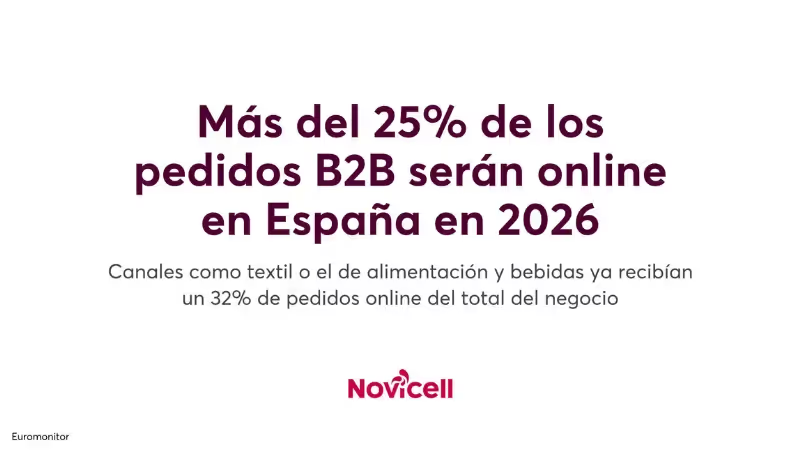
A survey that Alibaba did with Euromonitor, says that In 2026, 1/4 of B2B orders will be placed online. If we also see a distribution of the markets where we sell from Spain and if we focus on textiles, for example, we see that we export mainly to France, Italy, Portugal, Germany and Morocco. My customers have those markets and the website is only in English, isn't this curious?
Gonzalo: Sometimes we are not able to take off our hat and put on someone else's hat. Yes, these are very obvious things, but in the end it's not that easy to manage a website in 50 languages, with your own inventories, with your own taxes, with your own currency. So, of course, it's normal that this has been the case until now because only in recent years, technologies have started to arrive that allow you to create this flexibility without a prohibitive cost. In addition, this can also be invested; foreigners are also selling in Spain.
Leandro: Yes, it's a topic that I want to talk to you later. When we talk about multichannel. But first, in this survey we see the real evolution and the projection in recent years of evolution between different countries in Europe. In Spain, we are not doing badly, we have other countries, but there is a Gap. What do you think we can do from Spain to close that Gap? From Spain, there are things we do well digitally, but there are other things where we are a little slow.
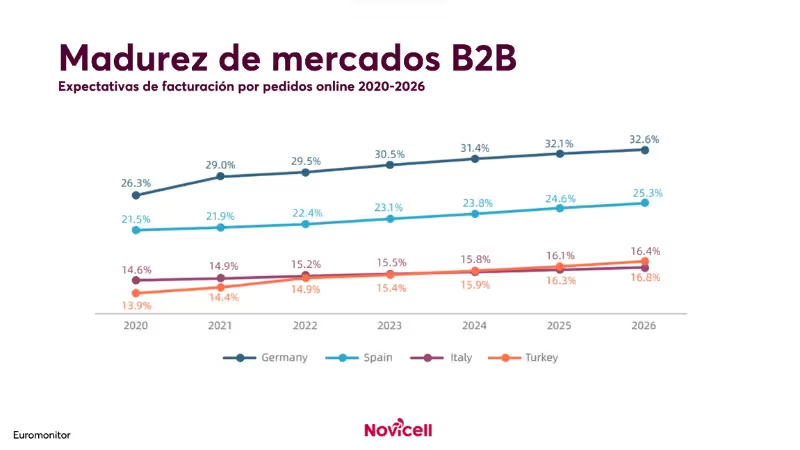
Gonzalo: Yes, I think that B2B e-commerce is precisely an area where there is still a lot to improve, as I said before, being able to do this, or for many companies to sign up for this, has depended on a change in Stock technological. A few years ago it was difficult, you had to have deep technological knowledge to do it well. But now less so, I think that we Spaniards are also a little bit risk-averse in some things, we tend to take a little longer to adapt technologies. I think there is the factor that Spain has taken longer to recover in the general economy, perhaps since the pandemic. Maybe this is one of the problems. They haven't recovered faster because they weren't digitized in Spain.
I think, in short, the message here is that there is opportunity. In other words, I think that companies that are already digitized or that are running their batteries now, within the B2B e-commerce sector. They still have a competitive advantage, in other words, they can enjoy a couple more years of competitiveness to attract new customers, since there are several sectors that are not very digitized. Then it will be a bit of the norm, if your company is not digitized you will be at a disadvantage.
Leandro: it's time to jump in, it's time to jump on the bandwagon and explore B2B eCommerce opportunities, what features exist, what's standard and what tailor-made. What are the standards that can already work for you and what are the customized functionalities.
Gonzalo: Yes, exactly, it's good, now there's a good mix. Well, we can talk later about composable or Composable.
eCommerce as a self-service channel
Leandro: let's talk about self-service, we call it as a concept, always talking about electronic commerce. I no longer need a person to come and sell me something or call someone. Otherwise I go directly to place the order online.
I have brought some slides that model in a very simple way the main challenges we have anticipated. Here what we see, in the axes, are the complexity of the product and the price.
Let's start with the era of B2B eCommerce, let's go with Amazon, right? When selling books, how difficult were you with pricing? Nothing, because the book was €20 and the product condition was the book, that's it, yes, hardcover, softcover, at best, as complexity. Then we are faced with the lowest situation of product complexity and price.

Now we went in with the wholesalers, who here started to get complicated as we wanted, we have more complex products, perhaps more complex lots and the price also varied by volume or by custom price, since management is complicated.
Or if I am a Manufacturer within the industrial sector and I have custom-made products, the complexity of the product is infinite, as is the complexity of pricing. What's the problem? That now users have the habit of buying online and expect the same shopping experience, in this ultra-complex system or business model and they haven't been able to have it until now.
Gonzalo: Of course, of course. But look, they want it, even though there are people who may not yet see it. In the end, remember when in the 2000s we only bought plane tickets online and we said “I would never buy clothes online, because I want to try them on and the sizes and so on”. Now everyone is buying clothes online. Well, there are people who may not yet fully believe this, but it is a reality. Come on, and the shopping experience is the same.
Leandro: It's a complex job because to achieve that very careful experience in a very complex product, you have to put a lot of desire into it.
Gonzalo: You have to know how to manage. You have to think about what you say, there are very complex products. How many varieties of screws are there? How do you find them? Well, now you have to have a search engine, sometimes with an image, sometimes with reference numbers, etc. Each sector is different, but most problems have been solved very well with a B2B eCommerce, or this self-service portal.
Leandro: Good. I bring you more data and then I have a more open question to complicate our lives even more or to give even more support to the digital world.
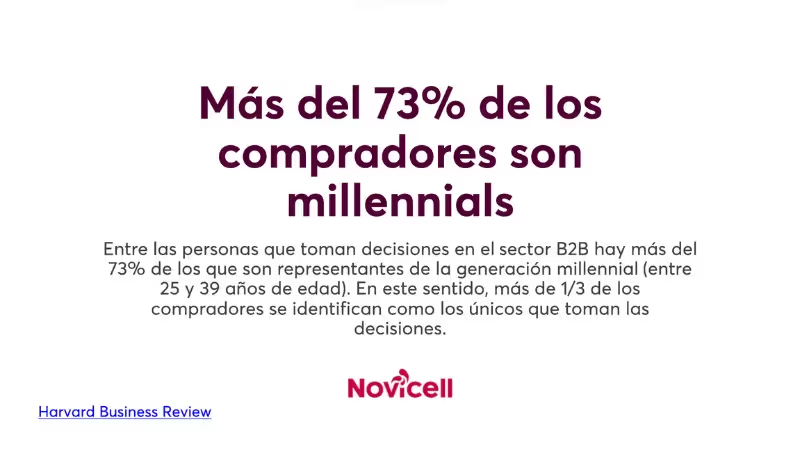
This survey is also very cool, which states that 73% of B2B buyers are millennials, of whom 1/3 have the definitive purchasing power, they are the ones who decide. We add to this a joke that is made many times in the press “Millennials are more connected to the phone and people already want to use digital media in a certain way.” So of course, if I have decision-making power in a company and I want to place an order, I am very willing to do it digitally.
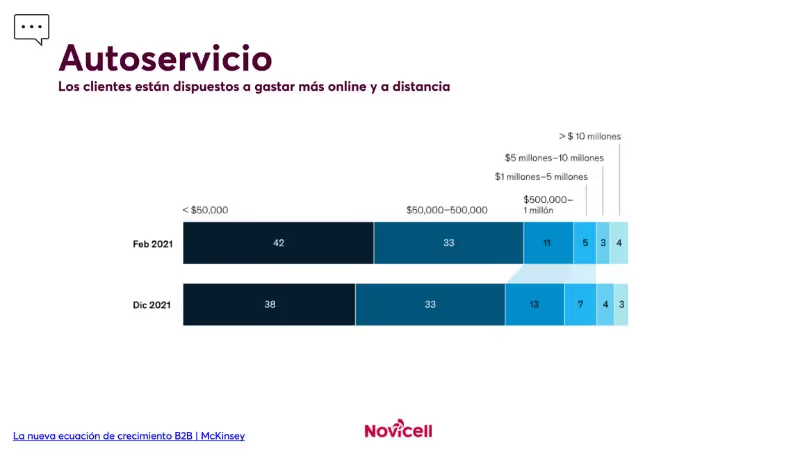
The next fact that I'm going to show you says that 1/3 of the respondents are willing to place orders of between 50K and half a million, that is, it is already trust in the channel, you have to have trust in the company, of course, but trust in the channel.
So we have confidence in the channel. We have a young population that also prefers digital channels. We are talking about the fact that the self-service portal opens up a very large world to us. The possibilities are enormous, of course. Here comes the question for you What are the advantages offered by this self-service portal?
Gonzalo: I would divide them into two main aspects. On the one hand, to gain efficiency and reduce costs and, on the other hand, to increase sales.
In the first aspect, the self-service channel allows the seller to take away a lot of administrative burden that they had to do before, of placing orders, transactions, etc., and focusing on the value that the channel actually provides: The relationship with the customer, talking about the company, about new products, serving more customers for each seller, etc. There you gain efficiency, when the customer can log in directly and place the order on their own. Then, since placing an order is very easy, many customers start to order smaller orders more frequently. Then everything becomes more predictable. Everyone's cash flow is better.
I come from the automotive world and there we always said that the chain is as strong as the weakest link, so of course, everything is a supply chain, right? And here we are already starting to see artificial intelligence systems that automate orders for you, etc.
On the other hand, The increase in salesWell, I think it's very obvious isn't it? Because you have access to all online channels, in other words, I think it's very proven, since the more channels a company has, the more it can sell. It's more a question of how to manage them.
There are a lot of people, because when their car breaks down instead of going to the dealership, which is very expensive, they go to websites where they can buy new products and of course, the seller, if he wants to access this type of sale, has to be digitized because he has to be able to connect with them Marketplaces. Then you not only access more channels, but also more geographies, you can start selling in France or Portugal, without having to have a sales force there.
Leandro: That's super interesting, I'm not even saying expanding directly into a market, but trying out a new market without such strong investment.
Gonzalo: Exactly, nowadays you have services of cross-border eCommerce that allow you to open in a country with no sales force, simply by setting up a B2B portal, which is in the country's language, with the country's currency, with the country's taxes. You are not going to sell in France, in English or in Spanish. You must have a minimum, but that investment is much cheaper than setting up a team or a Warehouse and then let's see if it works or not. Instead, you can do a much easier test with a self-service portal.
Leandro: It doesn't have to be the final situation, right? You can open in four markets, see the one that works best for you and understand if you invest in having a local presence, or not. Then you expand to the others.
Gonzalo: Exactly. It happens that all of a sudden, there is a dealer in Italy who has seen your product and wants to order you and you say, “oysters is that I can't sell to him.” Well, let's open a B2B portal in Italy and see what happens. And then, logically it gives you access to do B2B digital marketing that, although each vertical is a world, in many verticals it is necessary, because it will bring you sales.
Leandro: we have done something similar in the agency with that we launched the website in Italian to understand if the market there responded and it's a way of seeing if it generates interest, generates traffic, you run a small campaign and then if it's starting to work for you, you already set up an office, hire people, a director, a lawyer to open the office or whatever. All that friction that we know well at Novicell when we have expanded to each country, what do you say “And if it doesn't work for me later” Try it first! But online it's much simpler, testing.
Omnichannel
Leandro: Well, we're still asking questions, we're going to get into a topic that's also very broad and I think it's really cool, the topic of omnichannel.
When we talk about omnichannel we can say a lot of things, talk about offline and online channels. We are now going to dedicate ourselves to talking about online ones, especially.
Offline ones are the classics, from the telephone, the press, ordinary mail, those channels where we are always predisposed to receiving orders. The fax. Yes, mind you, eh. There are markets where you can still order by fax. I don't know if you, I know that in Germany the fax is still something for some reason.
Well, when we talk about omnichannel, we talk about more things, we talk about more channels and more depth of channels. What are the channels within B2B?
Gonzalo: well, they are usually very specific to each vertical, isn't it?
Un Retailer fashion that has multi-brand stores, maybe it belongs to a person who has set it up, has two or 3 stores and has a website. Well, that's an SME owner. This person buys for your company as if they were buying for themselves. If you are a clothing brand and you want to access that distribution channel. Well maybe you have to have an Instagram account, where you attract not only the end user, but also a potential distributor or a point of sale that he's going to like your clothes, he's going to fall in love with the brand, he's going to go to the web and he's going to say, “oh, well, see if I can access it as a company and I can buy and place a large order” with dealer prices.
Leandro: What you're saying is super cool because The wholesaler will see and sense the demand through your use of B2C channels, even if your interest is to sell in B2B, this will apply.
Gonzalo: Of course, and then you already have the specific forums that exist for each vertical. We used to talk about automotive before, but there are also many other forums in pharmacies Marketplaces, there are publications specific to verticals. You can place an ad so that people end up going directly to your B2B portal, they will see that they have a product similar to the one they are already buying offline.
Leandro: There was a slide that we saw at the beginning. I said that for B2B buyers there was an issue that was critical, which was the consistency of the information, because when we opened up to more channels, we also opened up to selling with different descriptions, different photos, different products, different sizes, sizes, etc. It is crucial, in order to have the customer's trust, that the same information is present in the different channels.
Gonzalo: Not only about information, but also about prices, it's very important to manage prices. If I have a distribution network, I don't want to compete with my own website or with my distributors for a lower price. With these new technologies, it is better managed.
Leandro: with eCommerce features, I can directly connect the Marketplaces to my product information, for example.
Gonzalo: correct and I can have my product in a series of Marketplaces of the sector. Nowadays, social networks are also starting to sell. Meta, which has its own stores. TikTok has already released the Tik Tok Shop in the United States, which is coming to Spain. It's inevitable that we'll all end up buying on social media because you're there watching a video of a girl, wearing a very nice dress and you can buy it right there.
Leandro: I think it's interesting because that person who has a dress that I like and so on, I click because I want to see more information about the product, I'm not going to buy it for myself, but I want to sell it in my online stores.
Gonzalo: To do business, of course. Well then when I click, if that is going to lead me to a portal that allows me to easily start doing business with it. Well, they're likely to try it.
Composable
Leandro: Let's go with the last point of the talk. Theme composable, is called modular here, is that idea of being able to have the best solution with the best pieces of each one.
I'll show you how I explain it to him. You know that we are very much with composable. Your solution is within the world ComposableAnd and we as implementers advocate for that. In fact, we belong to a single alliance of companies that believe in this: the MACH Alliance.
So I show you how I tell customers the difference between composable and what we understand as a monolithic solution that already has everything.
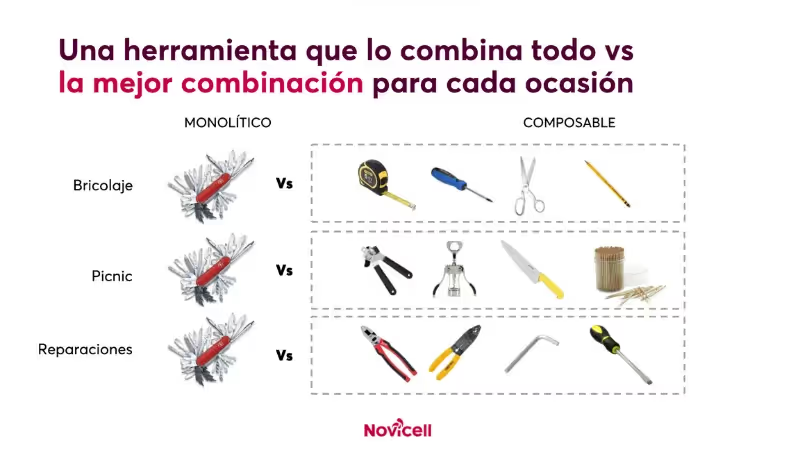
We have a Swiss knife that does everything, yes, but it does everything a little poorly. So if you want to do DIY, well, quickly adjust a screw, you're going to be able to. But if you want to dedicate yourself to DIY you'll want the specific tools, right? Instead of a tool that will do everything for me, which will fall short of me, I can choose the best tool for each moment.
So, I bring you this other survey carried out in Spain and Latin America, it talks about the frustration that manufacturers have when they are selling in B2B, in relation to their eCommerce tool. They have a limited connection to the ERP, they want power connect with an ERP to show all products and have the stock updated.

Customers use the self-service portal, but since there's no trust, it's a little Clanky. So they have those usability problems and they also have maintenance problems. Notice what it says: “80% of leaders are unhappy with their platforms” and “29% are frustrated by the high level of maintenance”.
Gonzalo: well, this is a bit of what we were talking about before, with the technologies available, let's say, in recent years, the only way to make a digitized B2B business model is with great pleasure, meditation, you need to adapt to each company, B2B models tend to be very specific.
Traditionally it could only be done with Open Source software or by creating Custom from scratch. This made you dependent on the development team, which had to maintain it. Maintenance is a cost that doesn't add value because you're there paying for it to work the same way. Of course, and if you don't want maintenance what alternative do you have? Well the SaaS.
In a SaaS platform, you have the functionality, which is what can cover 90% of people's cases. And if your business needs something that isn't there, then you have to adapt your business to technology, which is always what you have to try to avoid, right? But hey, nowadays this philosophy has grown, which promotes, for example, the MACH Alliance about making composite solutions, SaaS solutions with box functionality, but composed of different tools, with a very strong focus on connectivity, so that working together they can work at the same level of efficiency as a large suite.
Leandro: for example, let's think about a very classic B2B function: controlling order tracking. Imagine that as a manufacturer I also act as a distributor. So me with a solution composable, I could connect my own distribution network, to let my customer know the status of their order.
Gonzalo: Exactly, so you had to develop that part alone.
Leandro: Of course, I had to remove what was there by default. I can unplug standard functionality and connect something tailor-made.
Gonzalo: Exactly, or something that has already been done, that has been done by another company that are specialists in that or something that you have done in-house because it's something very specific to your business, which can even be a competitive advantage over others. Then that's all you have
Leandro: In another talk, we talked about the standard and the personalized, that with the standard we already have a lot of functionalities, but the standard will be available to our competence. Of course, it's that little detail that I can afford. I want double standards, but the ability to implement.
Gonzalo: well, BigCommerce and other solutions composable What is there, what we believe is that if you have solutions that are architecturally already designed to be highly interconnectable, in the end you can make and accept external developments. In the end, it is a matter of being more or less standard for everyone, we want to implement solutions in the fastest and cheapest way, with solutions Out of the box. And whatever you need to customize, make it as easy as possible.
You always need, of course, an expert like Novicell, who will recommend you based on your needs, what solutions are there that will cover a part of you and which part you will have to customize.
Leandro: You know why I like this philosophy, that we work hard on it, because our clients have a budget, if they want something that knows their business perfectly and we go with traditional solutions, they are going to leave a large part of the budget to develop things that are standard, but since they did everything with something very tailor-made, they have very little value.
Gonzalo: That's why I really like working with Novicell and clients are always very happy because let's say that its value is business value, it's also technical value, of course, but it's a value that allows you to grow. It's not just to maintain and develop. You are business consultants, you already know a lot about technology, but you know about the eCommerce market, about how things work, about recommending.
Leandro: It's out of empathy with customers, you can't implement something if you don't understand how the business works.
Gonzalo: Of course, in the end, the customer who is paying for efforts aimed at growth, a development or an evolutionary one that will allow him to enter a channel or a new country, something that is to grow, is not simply to maintain.
Well, we're almost at the end of the talk. We have comments from the public.
Gonzalo: Look at what Pablo says “Much of the frustration of companies with their B2B portals is directly related to how sellers of those companies perceive B2B portals... They see it as a threat to their work and not as a tool that boosts their sales.”
I find that a lot, I think it's a bit of a myth, that a B2B portal will replace your sales force, if your sales force has an intrinsic value, beyond that. Pass orders, you're going to need it anyway. In fact, you are going to optimize its value because a seller will waste much less time placing orders and will be able to dedicate it to other customers or to a more active sale, right? That, on the one hand.
And on the other hand, what you said before, that uncomfortable moment of “So-and-so has already come to see me to tell me about his film and I know that at the end of the conversation he's going to hand me the order form and right now it's not going well for me because we don't have cash”, because whatever. You can free the seller from that “weird” moment that exists and allow him to go have a coffee with you.
Leandro: Of course. The sales force is not the sale, but it is the relationship.
Gonzalo: Or maybe I'll come to tell you a movie about a new product that exists or whatever, or where we're going as a company, but there's not going to be that moment of “and now you have to send me the order again. Remember, don't forget.”
Leandro: This point is very good. Pablo and I have seen it in our clients who are afraid of breaking the existing status quo, the sales team has a lot of strength. I read a very nice report that Deloitte put out, about usability that said, “we only know our customer through the sales team, we don't know them directly” Of course, then he has a lot of fantastic power and can continue to have the same or more with the support. They are a tool for them. And we have more questions, from Nadia.
Gonzalo: “80% of IT leaders are not satisfied with their platforms. What pain points do they have? For 29% it is the maintenance time. What would be others?”
Leandro: Nadia, the maintenance costs and the dedication of the team. We need a lot of equipment and needing equipment isn't just about cost. We need an internal team that is often doing other things. I have programmers, I need four programmers just to maintain it.
Gonzalo: what we found a lot with portals a little more than “legacy” or let's say with slightly older portals. For example, it lacks a lot of functionality. In other words, you can go there and what you can do is search for a product and place an order, little else. For example, if there's a special situation where the buyer is asking for a discount, or whatever, how can I make a quote and negotiate it with my seller? Well, I think there's a general lack of functionality. And then what I told you before that they are really boring, that is, they remind you that you are working. It costs, isn't it?
Leandro: There are platforms such as mailchimp, it's nice to work with mailchimp, a lot of work has been done on the experience, it doesn't have to be something boring from the last century. Nadia, here you will see the report “The Ripple Effect of E-Commerce”.
And you see that among the frustrations, there is the cost of maintenance, the trust of your customer in the platform. If it's boring, old, it's not the level, it doesn't work, it always crashes, I have it installed on a server that turns it off on the weekend, but on the weekend I still need to place the order to start on Monday without problems, anyway!
Conclusion
Leandro: Look, then let's close here with the following sentence: “B2B loyalty is at stake. Customers are more willing than ever to switch providers for exceptional omnichannel experiences.” It's a good opportunity, it's also a risk because the user is willing to seek that experience in this B2B, which is still a little Clanky, as we said before. Then we have to offer it to them, because if we don't offer it to them, other markets offer it to them first.
Gonzalo: B2B buyers are going to start jumping from suppliers as quickly as B2C customers do. That jump from one brand to another. Before, they didn't do it because of that relationship. But increasingly, relationships are going to weaken and they are going to focus more on experience.
Leandro: It's a little bit like B2B closure isn't that different from B2C after all, in terms of experience.
Gonzalo: not because we are all people. The buyer is also a person who wants to have a good experience.
Leandro: correct and in terms of functionality. It's a little different, that's right.
Well, thank you very much to everyone who has come, if you want to contact us, here you can search for Gonzalo or me on LinkedIn or contact us by any means you want. I hope you liked it.
Cómo podemos ayudarte
Consulta los servicios con los que te ayudaremos a conseguir tus objetivos digitales.
.avif)